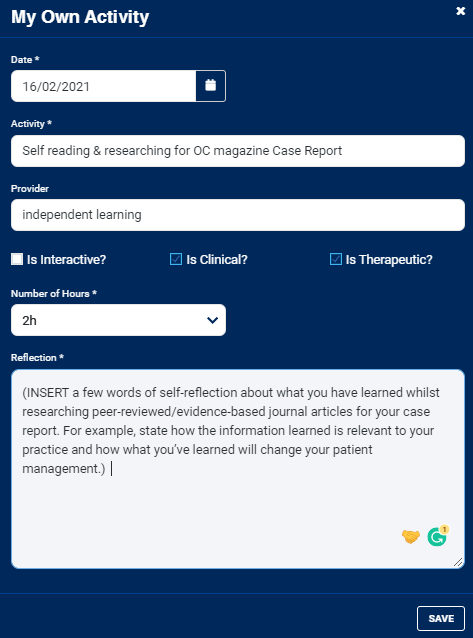We invite optometrists to submit their own case reports and/or images to be considered for publication. Members of Optometry Australia (OA) and the New Zealand Association of Optometrists (NZAO) will be eligible to be nominated for the Optometry Connection Case Report and Clinical Image Award. The Award is an AUD$1,000 cash prize to be made to the author(s) of the most meritorious case study or clinical image published in Optometry Connection in a calendar year.
We welcome case discussions, from new graduates to more experienced optometrists.
We are aware that optometrists of a wide range of experience-levels, working in all workplace settings, come across interesting patient cases in their community. This is an opportunity for optometrists to communicate their patients’ stories and share key learnings with other optometrists.
In turn, you proudly see your case report or image published in Optometry Connection, both in print and online. Your name and workplace will be credited. The article/image is often shared widely on our social media platforms. A hard-copy of Optometry Connection is mailed to approximately 5,500+ optometrists in Australia and 570+ optometrists in New Zealand.
You can contribute by submitting a 200-word abstract of a possible case-report for consideration. If accepted, you will be invited to expand the abstract to a 1200-word case report. Topics can range from every-day clinical presentations to wider scope-of-practice themes, such as in preventative and public health.
Why write a case report?
Have you learnt something from an interesting patient presentation? Why not help other optometrists learn something too? A case report is a written method of communicating something that has been learnt in clinical practice. There are many examples of what can be communicated in a case report, such as:
- an unusual or complicated presentation;
- ethical or practical challenges with management;
- a difficult diagnosis; or
- an unexpected outcome.
Case reports allow other optometrists to learn from your experiences and apply these learnings to their patient care in the future.
Here is a short video outlining the merits of writing a case report.
Planning your case report
Once you have identified a case that you’d like to write up, ensure you have the patient’s consent for use of their information and images. You should never provide identifying details in a case report.
Next, you should undertake a literature review using sources such as PubMed, Medline, Web of Science and Google Scholar. Some tips on undertaking a literature review can be found here. Use high quality sources whenever possible, and in order of quality (highest first). Sources can be systematic reviews, guidelines, randomised control trials, cohort studies and other case reports.
Now, start to plan your case report by creating dot points:
- Why is the case important/relevant?
- What is the pertinent case information (key aspects from history, tests, relevant investigations, management)?
- Were there any key images/reports?
- What were the differential diagnoses considered?
- What was the diagnosis and what led to this?
- What was the management (goals of treatment, referral timelines, etc)?
- Write a single sentence on the main points you want to get across to reader – what is the key takeaway?
Step-by-step guide
Once you’ve created your case report plan, you can start to write. See Table 1 below for a step-by-step guide on writing a case report.
Table 1: Case report checklist, adapted from the CARE guidelines checklist1
| Item name | Brief description |
Title
(<10 words) | - Brief and informative
- A catchy title is always appreciated, but not necessary |
Introduction
(~300 words) | - Catchy opening sentence
- Justify why the case is important/relevant
- Give background of case
- Explain the condition, usual presentation and progression (epidemiology/background of disease). Use references. |
Clinical findings
(~400 words) | - Provide pertinent findings in chronological order
- Provide results from key tests and their impact on diagnosis and decision-making
- Describe diagnostic challenges and prognostic characteristics (e.g., staging), where applicable
- Describe the treatments (e.g., pharmacological, preventative, referral etc.) and final diagnosis adequately
- Summarise the clinical course of all follow-up visits and outcomes |
Discussion
(~400 words) | - Expand on the main points you want to get across to the reader
- Interpret key findings and compare to published literature (e.g., suitability of clinical guidelines, interpretation of key tests, challenges of case and why)
- Describe best practice management and discuss strengths/ limitations of the management of this case. Compare and outline evidence-based management protocols
- Always back up your discussion with high-quality references |
Conclusion
(~100 words)
| - Key clinical pearls that you would recommend to others |
| Patient perspective | - Where possible, the patient should share his/her perspective |
Now that the bulk of the case report is written, proofread and edit. If possible, get a colleague to read the case report as well. Continue to edit and proofread until you are happy with the final product.
Clinical images
A clinical image is an anterior eye photograph, fundus photograph, ultrawide image, optical coherence tomography (OCT) or other clinical image of an unusual or interesting presentation. A clinical image submission is an abridged version of a case report, with a brief 300-word description of the case and disease presentation.
How to submit
Send us an abstract at publications@optometry.org.au and we’ll let you know if we can publish your case report or clinical image. An abstract is a 200-word summary of the case presentation and key messages of the submission. Full author guidelines, including advice on referencing, will be sent to successful applicants.
More information about submitting a case report or clinical image to Optometry Connection, including details of the Optometry Connection Case Report and Clinical Image Award, can be found on our website.
A collection of high-quality case reports and clinical images can be found here.
Questions? Contact us to chat to our friendly Optometry Connection team
Email: publications@optometry.org.au
Phone: (03) 9668 8500
References
- Gagnier JJ, Kienle G, Altman DG et al. The CARE guidelines: consensus-based clinical case reporting guideline development. BMJ Case Reports 2013: bcr2013201554.
- Sun Z. Tips for writing a case report for the novice author. J Med Radiat Sci 2013; 60: 108-113.
FAQ
 View
View



